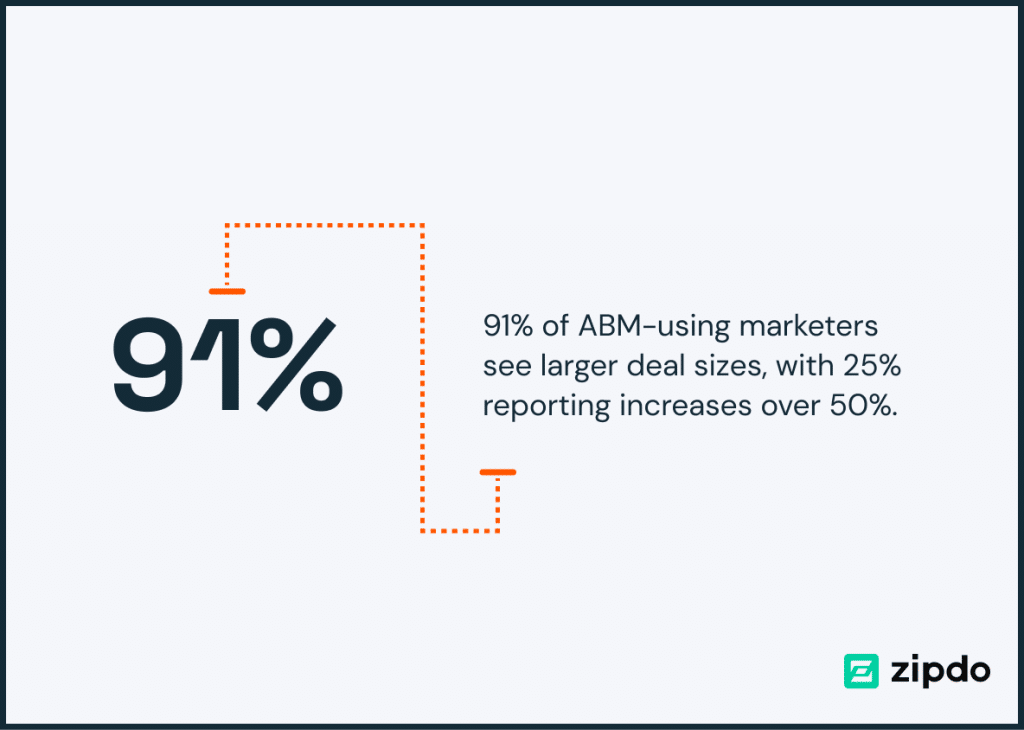By Michael Brenner for Marketing Insider Group
Account-Based Marketing (ABM) is really buzzing these days. Everywhere you look, there’s something new popping up about ABM – be it events, tech solutions, or those success stories and insights filling up our inboxes and social feeds. This buzz is stirring up some lively discussions, and let’s be honest, not everyone’s sold on it.
As people who’ve been rooting for ABM for a while, we get where the skeptics are coming from. There’s a bunch of smart people who aren’t quite ready to jump on the ABM bandwagon. A lot of the pushback, we believe, comes from a place where ABM is being used more as a set of tactics rather than as part of a broader, more thoughtful strategy. That’s where we’re missing the mark.
So, let’s dive into the 7 big critiques of Account-Based Marketing challenges we keep hearing about and explore why these might be more about tactical missteps than flaws in the ABM strategy itself.
1. Account-Based Marketing Only Supports Outbound
Account-Based Marketing seems to have reinvigorated the direct-mail marketing industry. It’s as if most of the case studies involve tales of some sort of direct mail-based outreach to executives at targeted accounts that resulted in impressive returns and engagement within those accounts.
What we don’t hear much about is leveraging an account-based strategy with inbound tactics. As a result, it may lead some to believe that ABM doesn’t play well with inbound or a content strategy — and that is far from the truth. Truly strategic Account-Based Marketing folds account-based considerations into the development of a content strategy, which is what will best fuel your inbound marketing efforts.
The outbound content most tactical account-based marketers are using is typically product-focused and does not serve to educate and establish trust with buyers. The result? Lots of impressions, but low engagement.
Consider the foundation of a good content strategy — the development of personas for all of your buyers, including influencers as well as decision makers across the buying committee. Adding an ABM layer to this means that you need to figure out what types of companies are in your sweet spot, zero in on the specific needs of buyers from those types of companies, and prioritize the development of personas from “premium” account types.

Creating the content that speaks to the needs of buyers from target accounts, across the entire span of their buyer’s journey, will create the complimentary inbound component to the obvious outbound tactics that can be applied to ABM.

Image Source: Qualtrics
2. Account-Based Marketing Alienates Prospects and Customers
Maria Pergolino from Apttus recently posted a few articles that shared some stories of targeted, account-based campaigns that were unsuccessful (here and there). The campaigns left some potential buyers and existing customers feeling either left out or unappreciated as they were excluded from opportunities that they felt they should have been a part of. The mistakes made were largely tactical in nature:
Existing customers were largely excluded in favor of landing new logos
As Justin Gray said in the comments of Maria’s post, “Customers should always be the first VIP’s.” It is much easier (and less expensive) to support an existing customer than to land a new one. In fact, the origins of Account-Based Marketing are often traced back to expanding your presence across key accounts that are already customers.
Recent applications, however, seem to be exclusively focused on new logo acquisition. Ignore existing customers at your own peril. Excluding them from your marketing strategy means you will lose market share, strategy or not.
Targeted campaigns focused on specific accounts left buyers feeling underserved and excluded
If these efforts are extreme and visible, such as at a content marketing event or on social media, you run the risk of losing potential buyers due to insensitive messaging or “elitist” tactics. Tread lightly and consider carefully how your marketing efforts will be perceived. Never alienate a viable buyer simply because they are not “on the list.”
Truly strategic ABM accounts for buyers that might fall outside the parameters of your target list, while still focusing on the companies that are the most likely to buy.
3. Integrating ABM with Overall Marketing Strategy
Integrating Account-Based Marketing with your overall marketing strategy is crucial for achieving cohesive and effective marketing efforts. According to ZipDo, 91% of marketers using ABM see larger deal sizes, with 25% reporting increases over 50%.

Image Source: ZipDo
The key to successful integration lies in aligning ABM with your company’s broader marketing goals and tactics. This alignment ensures that ABM does not operate in isolation, but compliments other marketing initiatives. For instance, while ABM focuses on key accounts, it should also support and be supported by:
- General brand awareness campaigns
- Content marketing
- Digital marketing efforts
To effectively integrate ABM, start by identifying the common goals between ABM and other marketing strategies. This could include shared objectives like:
- Increasing brand awareness
- Generating high-quality leads
- Driving sales in specific market segments
Once these common goals are established, develop a unified strategy that leverages the strengths of both ABM and other marketing tactics.
For example, use insights gained from ABM to inform your content marketing strategy, ensuring that the content is highly relevant and tailored to the needs of key accounts. Similarly, digital marketing campaigns can be designed to not only target a broader audience, but also to specifically engage decision-makers within identified key accounts.
Remember, the integration of ABM with your marketing strategy isn’t going to be a one-time effort. It’s an ongoing process. Regularly review and adjust your strategies to make sure they remain aligned and effective in achieving your marketing objectives.
4. Customizing Content for Specific Accounts
Customizing content for each account in ABM is a game-changer. Here’s a stat to think about: 56% of marketers believe that personalized content is crucial for ABM success.

Image Source: strategic abm
This shows how important it is to tailor your content to fit the unique needs of each target account.
So, how do you nail this? Start by diving deep into understanding your target accounts. What challenges are they facing? What goals are they chasing? For example, if a target is grappling with digital transformation, your content should offer insights and solutions that speak directly to this issue.
The next step is making sure this tailored content reaches the right people. It’s not just about sending out emails or posts; it’s about connecting with key decision-makers and influencers in a way that resonates with them. Whether it’s through targeted emails, social media, or custom web content, the aim is to engage them with material that feels like it’s been created just for them.
Lastly, keep an eye on how your content performs and be ready to adjust. If certain topics get more engagement, focus more on them. If a particular style gets more response, use it more. It’s all about being flexible and responsive to what works for each account.
5. Account-Based Marketing Puts Sales In Control of the Marketing Process
Marketing has come a long way over the past decade, largely due to the rise of marketing technologies that allow us to better measure the return on our efforts and investments. Marketers are now able to prove:
- What is working
- What drives leads
- Which leads turn into opportunities
- Which marketing programs drove the most revenue
However, poor visibility into turn-backs (marketing “qualified” leads rejected by sales) and perceived problems with lead scoring and closed-loop reporting still hurt us when it comes to establishing value and measuring performance.
Account-Based Marketing proponents (like myself) often cite that highly scored leads get ignored by sales because they are coming from companies that they don’t feel that they can sell to.
The establishment of a target account list and adoption of an Account-Based Marketing strategy that leverages that list can serve to solve that problem. However, there is a tendency to take this too far — giving sales control of the list and a license to reject qualified leads that are not “target accounts.”
To remedy this, marketing needs to work with sales to compile the list, but needs to own the list and the strategies and tactics used to market to that list. These tactics need to be both inbound and outbound.
We also need to:
- Account for qualified buyers coming from outside “the list,” establish clear and precise lead scoring and lead management practices.
- Maintain service-level agreements with sales detailing responsibilities that account for qualified leads coming from both inside and outside the list.
- Build our Demand Process to focus on supporting a buyer’s journey and engage buyers with the tactics that drive revenue.
6. Scaling ABM Efforts
Scaling your ABM efforts is a big step, but it’s totally doable with the right approach. Here’s something to think about: only 17% of marketers have a mature ABM strategy, which suggests there’s a lot of room for growth and improvement in this area.
So, how do you scale up without losing the personal touch that makes ABM so effective? First, focus on getting your data and insights right. This means having a solid understanding of your target accounts and continuously refining this knowledge. As you grow, your ability to collect and analyze data should also expand, helping you to make more informed decisions.
Next, think about how you can use technology to your advantage. Automation tools can be a lifesaver when it comes to scaling. They help manage the increased workload without compromising the quality of your interactions with each account. But remember, automation should enhance your strategy, not replace the personal elements that make ABM work.
Another key aspect is ensuring your team is on the same page. As you scale, keeping everyone aligned becomes more challenging but also more important. Regular training and communication can help maintain a unified approach.
Finally, don’t forget to measure and adjust as you go. Scaling up means new challenges and learning opportunities. Keep an eye on your key performance indicators and be ready to tweak your strategy as needed.
7. It is Difficult to Measure and Monitor Account-Based Activity
There are some inherent limitations in the technologies we are using that do not support an Account-Based Marketing strategy.
Some new technologies have come to the fore seeking to address these difficulties. Engagio, for example, works to supplement your existing marketing automation platform with an account-based view into engagement and activity. And Demandbase has long offered tools that work within your web analytics to monitor account-based activity across your web properties (among other account-based outbound marketing offerings).
Video Source: Demandbase
As popular interest in ABM has grown, technology vendors are rising to the challenge with some impressive technologies to add to the stack.
Technology is not a silver bullet, however. It seems too easy to lose sight of the simple fact that incorporating account-based considerations into content strategy and lead management processes are what will best serve to bolster any Account-Based Marketing strategy and drive revenue. The best technologies fail without a solid Demand Process strategy to drive them.
The most effective Account-Based Marketing programs take a strong demand generation strategy and build upon it by folding account-based considerations into the tactics that drive the best returns for your company.
And the truth is, a strategic Demand Process that incorporates content strategy, inbound and outbound engagement tactics, and lead management process can trump any sort of Account-Based Marketing strategy.
You need to master the fundamentals first. Once that is done, adding some strategic account-based components is what will take you to the next level.
Overcome Account Based Marketing Challenges Today with MIG
Navigating Account-based Marketing Challenges calls for a blend of strategic thinking, personalized content, and scalable approaches. By understanding and addressing these challenges, marketers can unlock the full potential of ABM, turning obstacles into opportunities for growth and success.
